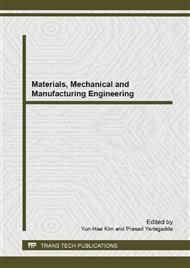p.363
p.367
p.374
p.378
p.382
p.386
p.391
p.397
p.401
Using Stress Relaxation Data to Predict Creep Behavior
Abstract:
An estimation method to predict creep performances of high temperature structural materials has been proposed. A Stress relaxation equation is obtained by fitting stress relaxation testing curves and modifying Tanaka-Ohba reloading stress relaxation constitutive equation. Based on the relationship between stress relaxation and creep, a unified prediction equation of creep is deduced. The method is to use the unified equation to derive creep strain rates or creep strain vs. time curves from stress relaxation measurements through some specified time increments. In order to validate the approach, the predicted results are compared to the experimental results of uni-axial isothermal creep tests conducted on 1Cr10NiMoW2VNbN steel. Good agreement between results of creep tests and the predicted results indicates that the developed method can be recommended in the creep behavior evaluation of high temperature materials.
Info:
Periodical:
Pages:
382-385
Citation:
Online since:
November 2013
Authors:
Keywords:
Price:
Сopyright:
© 2014 Trans Tech Publications Ltd. All Rights Reserved
Share:
Citation:


